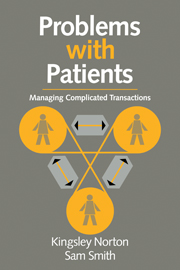Book contents
- Frontmatter
- Contents
- Foreword by Professor Paul Freeling, O.B.E.
- Preface
- Acknowledgments
- 1 Doctor–patient interaction
- 2 The clinical transaction
- 3 Interpersonal influences
- 4 The influence of past relationships
- 5 Contextual influences
- 6 Managing complicated clinical transactions
- 7 Interventions in complicated clinical transactions
- 8 Implications for the clinical setting
- 9 Implications for training
- Appendix I Clinical phenomena related to ‘problem patients’
- Appendix II Personality disorder
- References
- Index
2 - The clinical transaction
Published online by Cambridge University Press: 19 March 2010
- Frontmatter
- Contents
- Foreword by Professor Paul Freeling, O.B.E.
- Preface
- Acknowledgments
- 1 Doctor–patient interaction
- 2 The clinical transaction
- 3 Interpersonal influences
- 4 The influence of past relationships
- 5 Contextual influences
- 6 Managing complicated clinical transactions
- 7 Interventions in complicated clinical transactions
- 8 Implications for the clinical setting
- 9 Implications for training
- Appendix I Clinical phenomena related to ‘problem patients’
- Appendix II Personality disorder
- References
- Index
Summary
Introduction
Mrs Black, a mother of three children and a part-time telephonist, developed a painful throat and swollen glands during the course of an evening. She had a headache and fever, for which she took paracetamol. The next day her symptoms were more severe and, unable to work, she decided to consult her doctor, making an appointment to do so. When Mrs Black was seen and examined, the doctor, who knew her well and liked her, diagnosed acute tonsillitis and, communicating this to her, prescribed an appropriate antibiotic. Mrs Black complied with this treatment and recovered over the next few days.
This simple vignette is a common enough example of a clinical transaction in primary care with an outcome satisfactory to both doctor and patient. The term ‘clinical transaction’ is introduced here to refer specifically to the two-person, interactive system of doctor and patient. It embraces both the public and personal domains of their interaction. To ‘transact’ means: ‘to carry through negotiations: to have dealings; do business; to treat; to manage or settle affairs’ (Shorter Oxford English dictionary). A clinical transaction, therefore, is defined as: an appropriately negotiated, goal-orientated interaction between doctor and patient, comprising both public and personal components.
The process of the clinical transaction, considered as a negotiation, implies that patient and doctor share a more equal status than that of the traditionally portrayed doctor-patient interaction, even if certain inequalities remain. This differs from the traditional conception of the consultation, wherein the patient is regarded as a relatively passive recipient of advice or treatment.
- Type
- Chapter
- Information
- Problems with PatientsManaging Complicated Transactions, pp. 19 - 36Publisher: Cambridge University PressPrint publication year: 1994



